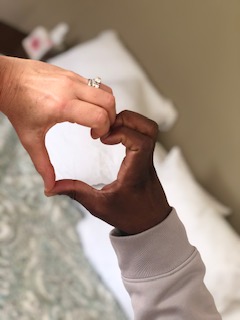Despite my birthday being in February, the month of June holds a special place in my heart for a few reasons: My wedding anniversary is June 9, my first child was born on June 12, and my parents’ anniversary is June 22. Plus, there’s Father’s Day (not that I’m a father, but it’s nice to honor my own), school’s out for the summer (which means no more yelling at a grumpy teenager every morning), and we celebrate Pride Month, Juneteenth, and Loving Day. While I’m not a big “celebration” girl (or one for crowds), all of these events are important to me — especially Loving Day, because without it, neither my anniversary nor my oldest son’s birthday would have been possible. So it’s a pretty big deal to me.
Don’t know what Loving Day is? Pull up a chair, I’m about to drop some knowledge.
Virginia is for Lovers … But apparently not for Lovings
Back in 1958, a Black woman named Mildred Jeter and a white man named Richard Loving fell in love and wanted to get married. But interracial marriage was illegal in Virginia, where they lived, so rather than break the law, they drove to Washington, DC to be legally married. The problem was, when they returned home to Virginia to start their lives together, they unknowingly broke another (ludicrous) law which forbade interracial marriage in the state, regardless of where the marriage took place.
Within a few weeks, the Lovings were arrested and charged with a crime punishable up to five years in prison. The judge offered them a deal: One year in jail, or leave the state and not return together for 25 years. The Lovings opted to leave, and they moved to Washington, DC, where they knew no one.
Loving v. Virginia
By 1963, as the Civil Rights Movement was picking up, Mildred had decided enough was enough. She wrote a letter to then US Attorney General Bobby Kennedy, who referred her to the ACLU, who in turn referred her to a young attorney named Bernard Cohen. Cohen, partnering with another young attorney, Philip Hirschkop, spent years working to appeal their case, arguing that the Lovings were denied equal protection under the law, as guaranteed under the 14th Amendment to the US Constitution.
Their case, Loving v. Virginia, went as high as the US Supreme Court.
On June 12, 1967, the Supreme Court unanimously ruled in their favor, declaring it illegal for any state in the US to enact laws against interracial relationships and marriages.
The Lovings had finally won the right to live together, legally, as a family — nine years after they were first arrested, and ninety-nine years after the amendment that protected their humans rights was ratified.
Why it Matters
Do I really need to explain this?
With the Supreme Court’s landmark decision, centuries worth of racist laws across the country were stuck down. According to Pew Research, in 1967, when miscegenation laws were first overturned, only 3% of marriages were between people of different races or ethnicities. By 2015, that percentage grew to 17. I imagine it’s even greater now in 2022, but I couldn’t find any recent stats to quote.
Had the Supreme Court not ruled in favor of the Lovings, my life would be very different. My cousin Bryan’s life would be very different. Our friends Lisa and Robert, Bob and Tram, Jeff and Alicia, Tchaka and Jen, Dan and Jobi, Jopi and Farnaz, Chris and Anh, Lissa and Farzanah, Kathy and Al, … All their lives would be different. My family — and theirs — wouldn’t exist. My boys wouldn’t exist.


Putting it in Perspective
It’s crazy to think that interracial marriage has only been legal for 55 years. I’m 50 and my husband (the Mildred to my Richard) is 53 (okay, he’s 52, but his birthday is in 3 months and I like to round up). This law basically came into law during our lifetime (again, if you round up, like I do).
What’s even more absurd is when you think about it in terms of America’s history with racism: Slavery was abolished in 1865 with the signing of the Emancipation Proclamation — that’s 102 years before the Loving case, for those who aren’t good with math; former enslaved Black people were legally deemed US citizens with equal protection under the law in 1868 when the 14th Amendment was ratified — that’s 99 years earlier than Loving v. Virginia; and both segregation and discrimination against a person based on race, color, religion, sex, or national origin became illegal under the 1964 Civil Rights Act — 3 years before Loving, but 1 year after Mildred Loving began her fight for justice. If you don’t see the institutional racism there, you aren’t looking.
I feel it’s also necessary to add that just because interracial marriage is legal, doesn’t mean it’s always easy. Not even in 2022. There are still plenty of ignorant, bigoted assholes who don’t agree with it, but I’ll leave the stories of microaggressions and blatant racism for another time. Today, it’s about love, positivity, and gratitude for those who came before us.
Thank you, Mildred and Richard Loving, for fighting for love. For fighting for equality. For fighting for us.


-LJDT


